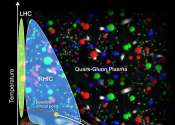Physicists make new predictions about the collision of heavy ions at very high relativistic energies
When two heavy ions collide at very high relativistic energies, they penetrate one another, during which they become excited and are slowed down. This "stopping" process can be generated experimentally, as demonstrated on ...









